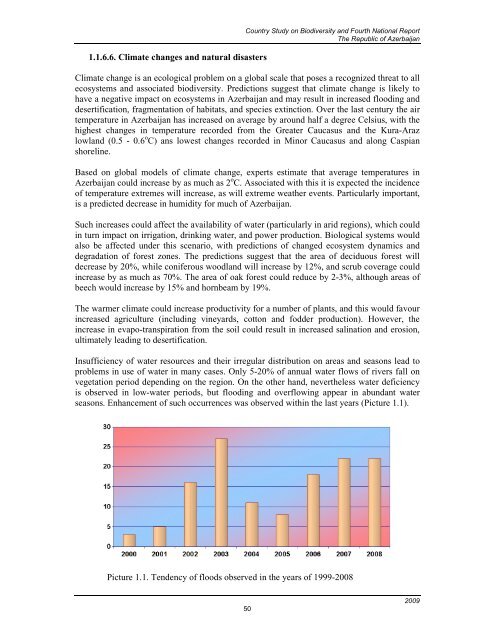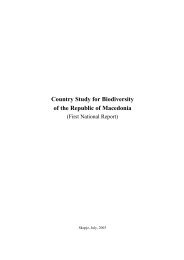CBD Fourth National Report - Azerbaijan (English version)
CBD Fourth National Report - Azerbaijan (English version)
CBD Fourth National Report - Azerbaijan (English version)
Create successful ePaper yourself
Turn your PDF publications into a flip-book with our unique Google optimized e-Paper software.
1.1.6.6. Climate changes and natural disasters<br />
Country Study on Biodiversity and <strong>Fourth</strong> <strong>National</strong> <strong>Report</strong><br />
The Republic of <strong>Azerbaijan</strong><br />
Climate change is an ecological problem on a global scale that poses a recognized threat to all<br />
ecosystems and associated biodiversity. Predictions suggest that climate change is likely to<br />
have a negative impact on ecosystems in <strong>Azerbaijan</strong> and may result in increased flooding and<br />
desertification, fragmentation of habitats, and species extinction. Over the last century the air<br />
temperature in <strong>Azerbaijan</strong> has increased on average by around half a degree Celsius, with the<br />
highest changes in temperature recorded from the Greater Caucasus and the Kura-Araz<br />
lowland (0.5 - 0.6 o C) ans lowest changes recorded in Minor Caucasus and along Caspian<br />
shoreline.<br />
Based on global models of climate change, experts estimate that average temperatures in<br />
<strong>Azerbaijan</strong> could increase by as much as 2 o C. Associated with this it is expected the incidence<br />
of temperature extremes will increase, as will extreme weather events. Particularly important,<br />
is a predicted decrease in humidity for much of <strong>Azerbaijan</strong>.<br />
Such increases could affect the availability of water (particularly in arid regions), which could<br />
in turn impact on irrigation, drinking water, and power production. Biological systems would<br />
also be affected under this scenario, with predictions of changed ecosystem dynamics and<br />
degradation of forest zones. The predictions suggest that the area of deciduous forest will<br />
decrease by 20%, while coniferous woodland will increase by 12%, and scrub coverage could<br />
increase by as much as 70%. The area of oak forest could reduce by 2-3%, although areas of<br />
beech would increase by 15% and hornbeam by 19%.<br />
The warmer climate could increase productivity for a number of plants, and this would favour<br />
increased agriculture (including vineyards, cotton and fodder production). However, the<br />
increase in evapo-transpiration from the soil could result in increased salination and erosion,<br />
ultimately leading to desertification.<br />
Insufficiency of water resources and their irregular distribution on areas and seasons lead to<br />
problems in use of water in many cases. Only 5-20% of annual water flows of rivers fall on<br />
vegetation period depending on the region. On the other hand, nevertheless water deficiency<br />
is observed in low-water periods, but flooding and overflowing appear in abundant water<br />
seasons. Enhancement of such occurrences was observed within the last years (Picture 1.1).<br />
Picture 1.1. Tendency of floods observed in the years of 1999-2008<br />
50<br />
2009

















